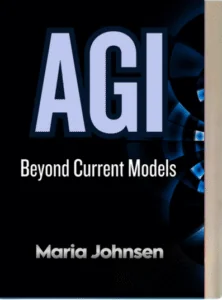AGI Beyond Current Models
AGI Beyond Current Models
We’ve been living in the Age of Prodigies. Machines make short videos, generate images indistinguishable from reality, and carry on conversations with a fluency that is, depending on the moment, either astonishing or faintly unsettling. To many, these feats mark the beginning of something new, a tentative emergence of intelligence from silicon and code. But in AGI Beyond Current Models, I argue otherwise. What we are witnessing is not the birth of mind, but a brilliant sleight of hand: statistical mastery masquerading as understanding.
The distinction may seem academic, but I believe it is crucial. Today’s AI excels within narrow corridors. It calculates probabilities with precision, adapts to patterns, and delivers outputs that mimic insight. Yet true intelligence, what we call Artificial General Intelligence, or AGI, is something more: the ability to reason across domains, transfer knowledge, solve novel problems, and do so with the depth and flexibility we associate with human thought.

AGI Beyond Current Models – The Phantom in the Code
In writing this book, I wanted to draw a clear line between what is and what might be. I take particular aim at the prevailing dogma of “scaling up”, the idea that by feeding these models ever more data, parameters, and compute, we will eventually stumble upon intelligence. The results, no doubt, are impressive. But I believe we are confusing growth with direction. Scaling, I suggest, is a brute-force march through complexity, not a climb toward comprehension. Bigger does not mean smarter. And behind every confident hallucination these systems produce lies a troubling reminder: they do not understand.
So I began to ask a different question, not what we can make AI do today, but what must exist for AGI to truly emerge. That question led me to a set of deeper, more elusive capabilities: causality, agency, intent. These are not technical flourishes but the bedrock of real cognition. A system must not only recognize patterns, but know why things happen. It must be grounded in the real world, capable of continuous learning, and possess the kind of unspoken, intuitive knowledge, what we call common sense, that no training set can capture on its own.
AGI Beyond Current Models – The Singleton Problem
From that foundation, I build a blueprint. Not a prediction, but a proposition, a way to think about thinking machines. True AGI, I believe, will require metacognition: the ability not just to think, but to think about thinking. It will need memory systems that resemble our own, episodic for experience, semantic for knowledge, working for the moment. It will need the creativity to set goals, the flexibility to plan, and most of all, the social intelligence to navigate a human world. Without a Theory of Mind, an understanding that others have beliefs, desires, intentions, AGI will remain an outsider to our most essential capacities.
And of course, there is the ethical spine of it all. Alignment is no longer a technical footnote; it is the centerpiece. If we are to design something capable of autonomous thought, we must ensure its aims remain aligned with our own. This is not a safeguard to be bolted on later. It must be integral to the architecture, woven into its reasoning from the start. I dedicate a large portion of the book to this problem, not simply because it is urgent, but because it is existential.
Among the thorniest of these concerns is what I call the “singleton problem”, the risk that one AGI, or one system behind it, achieves disproportionate control. It’s a scenario that calls for caution, but also for collaboration. Engineers alone cannot navigate this frontier. We need ethicists, philosophers, social scientists, voices capable of asking not just whether we can build such systems, but whether we should, and how we’ll live with them if we do.
AGI Beyond Current Models is not a prophecy. It is a field guide to chart a more thoughtful course. I do believe we must ask better questions. Intelligence, after all, is not just about processing power. It’s about judgment, reflection, and purpose. The challenge ahead isn’t how fast we can go. It’s whether we’re heading somewhere worth arriving at. Let’s not forget that Meta’s ( Facebook)”superintelligence” project is NOT AGI, but narrow AI. The name is misleading and the internet is filled with hypes and PR about his project. In my book, I’ve conducted a thorough assessment and comparison of the AI models from Meta, OpenAI, and Google Gemini.
Don’t just observe the future of AI, understand it. Get your copy of AGI Beyond Current Models
 AGI beyond current models on Amazon (Paperback ( Black and White, white interior, 489 pages))
AGI beyond current models on Amazon (Paperback ( Black and White, white interior, 489 pages))
USA, Canada, UK, Australia, Japan, Sweden, Netherlands, Germany, France, Italy, Spain, Poland
Amazon Hardcover ( color interior, white paper)
USA, Canada, UK, Sweden, Netherlands, Germany, France, Italy, Spain,
